When it comes to tires, we often look at the size, the tread pattern, and maybe the manufacturer, but there’s a whole world of coded information on the tire sidewall. That’s right! Our tires aren’t just round, black, and full of air, they are also full of information.
And they talk in a language that requires a little bit of decoding. So let’s take a look at the cryptic numbers and letters you may see on your tires: 120v, 120h, 120w, 120t, 120s, and 120q.
What do 120t, 120s, 120q, 120h, 120r, 120v, 120w mean on a tire?
Each of these letter-number combinations is a tire service description. This code indicates the tire’s load index and speed rating. The load index, the number portion of the code, tells you how much weight the tire can support when properly inflated. The speed rating, the letter that follows, indicates the maximum speed at which the tire can carry its load.
| Code | Load Index | Speed Rating | Max Speed |
| 120H | 1400 kg or 3086 lbs | H | 210 km/h or 130 mph |
| 120V | 1400 kg or 3086 lbs | V | 240 km/h or 149 mph |
| 120W | 1400 kg or 3086 lbs | W | 270 km/h or 168 mph |
| 120T | 1400 kg or 3086 lbs | T | 190 km/h or 118 mph |
| 120S | 1400 kg or 3086 lbs | S | 180 km/h or 112 mph |
| 120Q | 1400 kg or 3086 lbs | Q | 160 km/h or 99 mph |
What does 120T mean on a tire?
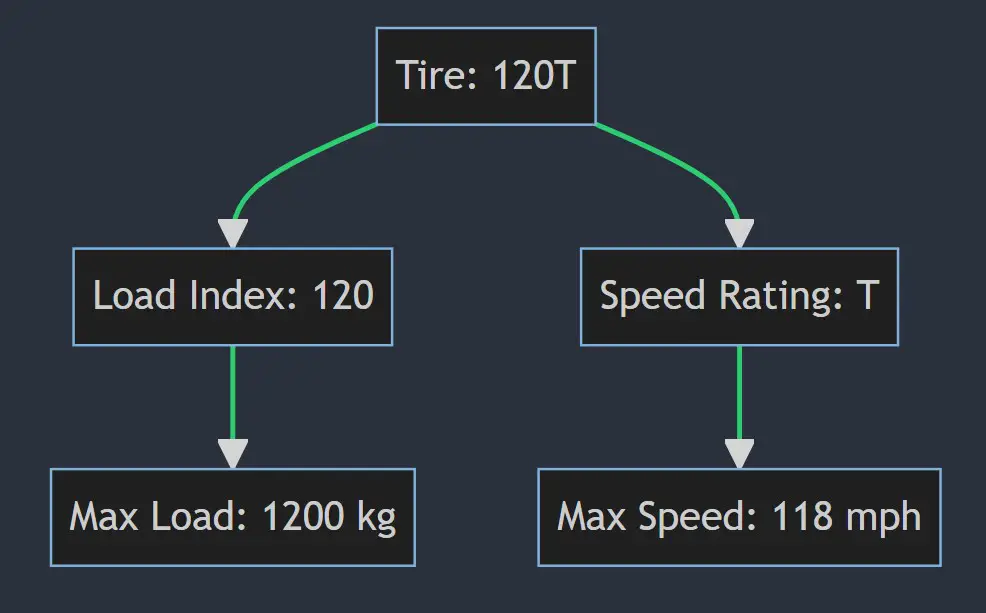
When you see “120T” on a tire, you’re looking at a tire with a load index of 120 and a speed rating of T.
- Load Index: The “120” is the load index. It tells you that this tire can support a load of 1400 kilograms, or 3086 pounds, when it’s properly inflated. That’s the weight of a small car or a big motorcycle, just to put things in perspective.
- Speed Rating: The “T” is the speed rating. It tells you that this tire can handle speeds up to 190 kilometers per hour or 118 miles per hour. That’s fast enough to get you in trouble on most highways, but slow enough to keep you safe on a racetrack.
So why would you want a 120T tire? If you have a vehicle that doesn’t need to go at breakneck speeds and is carrying a moderate load, a 120T tire might be a good, balanced choice. Just remember, driving safely is always about more than just the speed rating on your tire.
What does 120S mean on a tire?
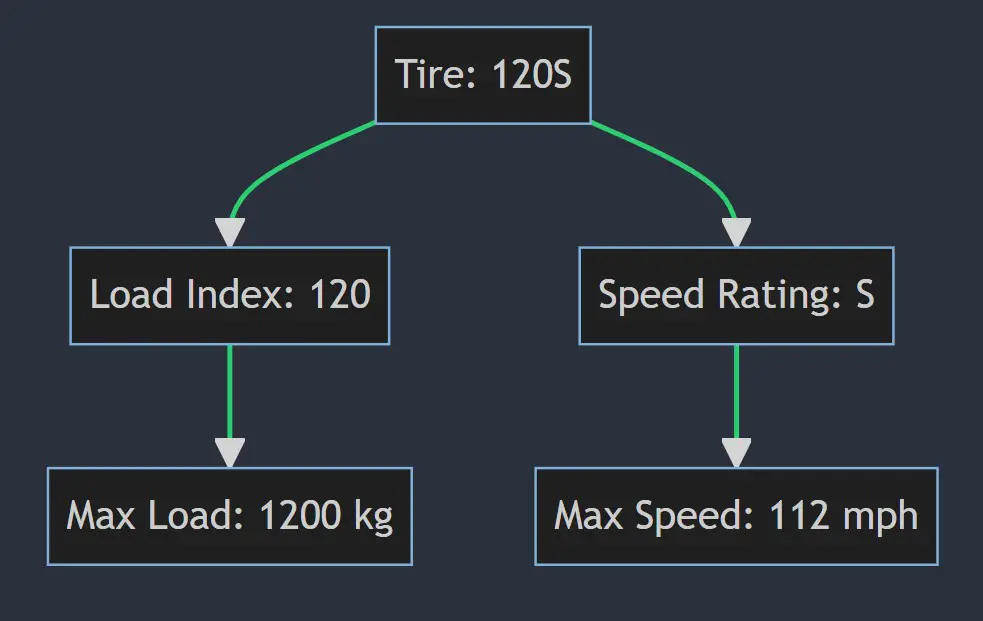
When you see “120S” on a tire, you’re dealing with a tire that has a load index of 120 and a speed rating of S.
- Load Index: Again, the “120” is the load index, and it communicates the same information as with the 120T tire. This tire can support up to 1400 kilograms or 3086 pounds when properly inflated.
- Speed Rating: The “S” speed rating indicates that this tire is rated to handle speeds up to 180 kilometers per hour or 112 miles per hour. That’s the kind of speed you’d expect from a typical family car, not a speed demon.
Choosing a 120S tire can be an economical and practical choice for many people. If you’re driving a vehicle that doesn’t require high-speed performance but does need to carry a reasonable load, an “S” rated tire could be an excellent choice. It’s a step down from a “T” rated tire in terms of speed, but it might save you some money at the pump. After all, slower speeds generally translate into better fuel economy, and who doesn’t love saving money?
What does 120Q mean on a tire?
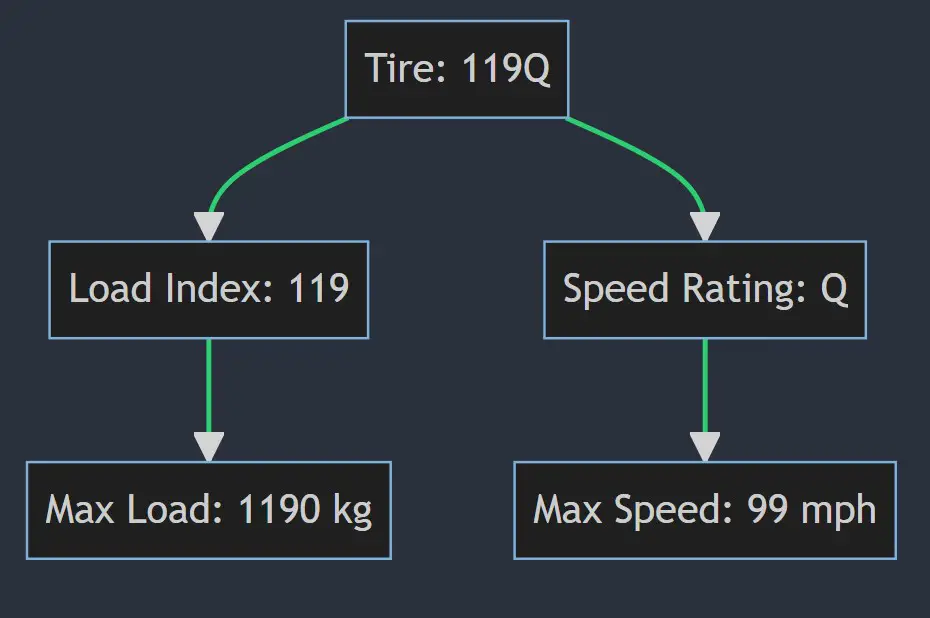
Ah, the mysterious “120Q” printed on a tire. It almost sounds like a secret code, doesn’t it? It’s akin to something you’d expect in a James Bond movie. Well, buckle up because we’re about to dive into the thrilling world of tire code deciphering.
- Load Index: “120” is the tire’s load index. It indicates that this tire can support a load of up to 1400 kilograms, or 3086 pounds, when it’s inflated properly. Now, that’s about the weight of an adult male hippopotamus. Yes, you heard it right, a hippo!
- Speed Rating: “Q” is the tire’s speed rating. It suggests that this tire can maintain its integrity up to a speed of 160 kilometers per hour, or 99 miles per hour. That’s faster than the top speed of an ostrich, the world’s fastest running bird, and even a Cheetah, the world’s fastest land animal! However, it’s important to remember that this is not a challenge to race against a Cheetah or ostrich, alright?
The 120Q tire is a good choice for everyday driving in a regular car or a light truck. It’s designed for modest speeds and moderate loads. If your daily commute doesn’t resemble a high-speed car chase from an action movie, this tire could be a solid, practical choice for you.
What does 120H mean on a tire?
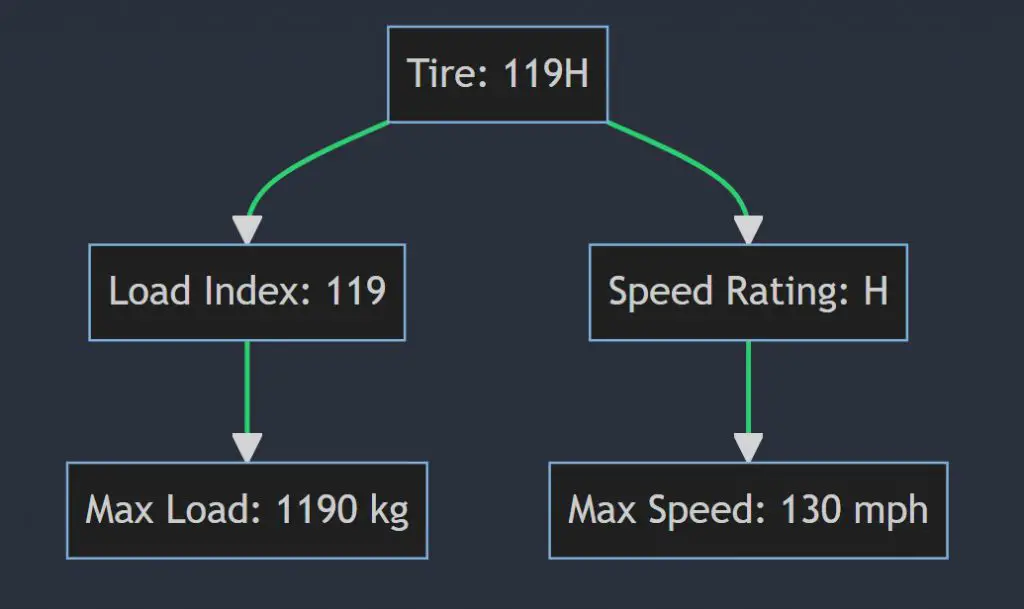
Let’s move onto the “120H”. It seems like the closer we get to the end of the alphabet, the more exciting these tire codes become!
- Load Index: “120” is the load index. By now, you’re probably a pro at this, and you know that it means the tire can carry a load of up to 1400 kilograms or 3086 pounds when properly inflated. That’s about the weight of a small car, or a very, very large tuna fish, if that’s a comparison that floats your boat (pun totally intended).
- Speed Rating: The “H” speed rating indicates that the tire can handle speeds up to 210 kilometers per hour, or 130 miles per hour. That’s faster than the top speed of the fastest horse ever recorded. But don’t get any ideas about entering the Kentucky Derby with your car—trust me, they won’t let you!
The 120H tire is a common choice for sports sedans and coupes. It’s perfect for anyone who likes a spirited drive but isn’t planning on setting any land-speed records. The “H” rated tire provides an excellent blend of performance, safety, and longevity. So if you like your ride a bit on the faster side, but also appreciate a good value, the 120H could be the Cinderella slipper of tires for you.
What does 120R mean on a tire?
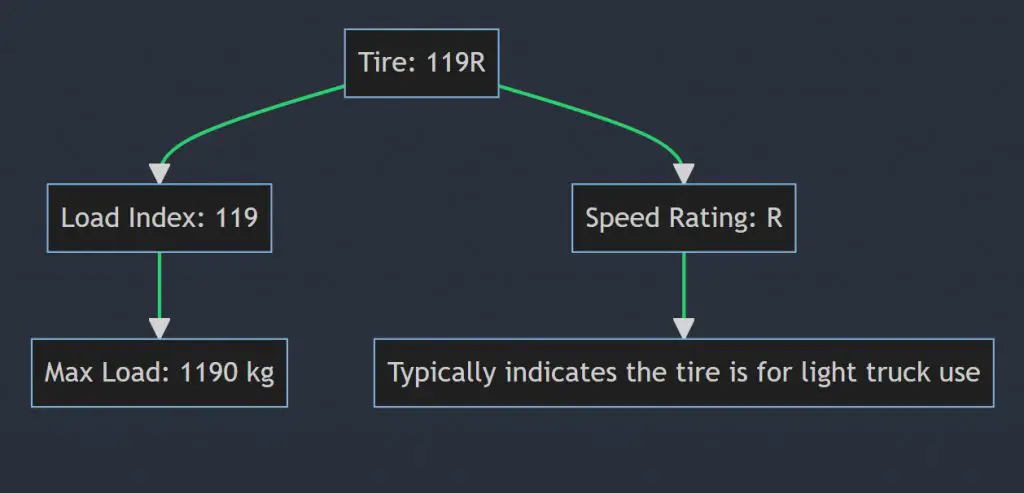
Alright, time to switch gears (pardon the pun) and explore the enigma of “120R” on a tire.
- Load Index: The “120” is our trusty load index, signifying that this tire can support a load of 1400 kilograms or 3086 pounds when properly inflated. Picture an adult male giraffe – yes, the tall and lanky creature with a long neck. Now that’s a lot of weight!
- Speed Rating: There seems to be a confusion here, as “R” in tire codes usually denotes the construction type, i.e., Radial. However, if you see an “R” in the speed rating, it might be a misprint, or it refers to a specialized tire type, as “R” is not typically used as a speed rating. Always double-check with your tire provider in such cases.
Now, if we stumble upon a misprinted tire in a spy movie, we might have a lead to a great adventure. In real life, however, it’s better to clear the confusion with your tire dealer!
What does 120V mean on a tire?
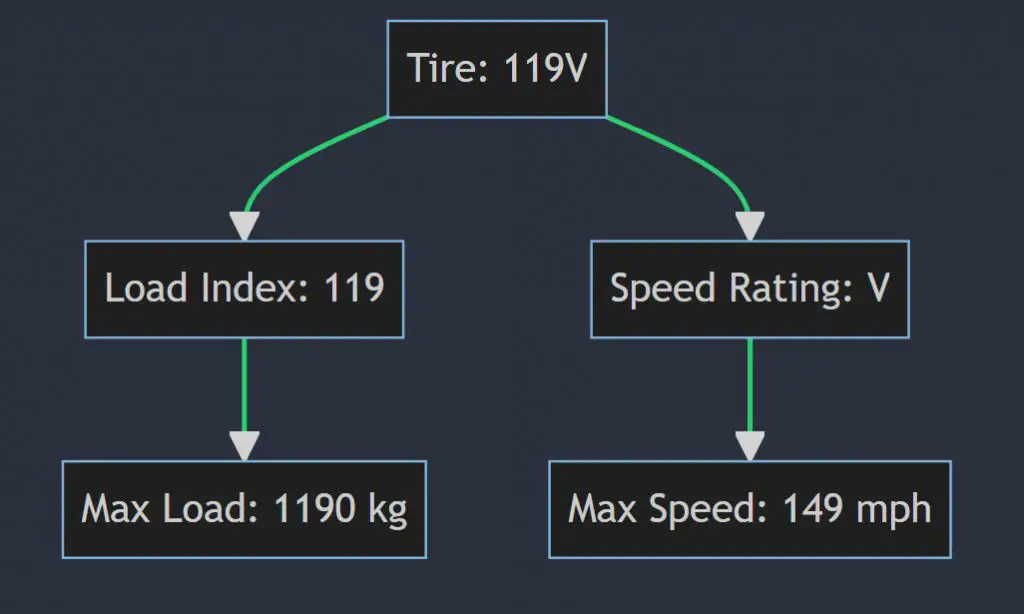
Let’s delve into the world of “120V” tires.
- Load Index: The “120” indicates a load index of 1400 kilograms or 3086 pounds when the tire is properly inflated. That’s about the weight of a grand piano… or four!
- Speed Rating: The “V” speed rating is where things get interesting. It signifies that this tire can maintain its integrity up to a speed of 240 kilometers per hour, or 149 miles per hour. If you’ve got the need for speed, this tire’s got you covered, but remember, always drive responsibly.
A 120V tire is often the choice for sports cars, high-performance sedans, and those of you who want a tire that sings “I Can Go The Distance”. However, be aware that high-speed tires often come with a shorter lifespan, as they tend to wear out faster due to softer rubber compounds used to increase grip.
What does 120W mean on a tire?
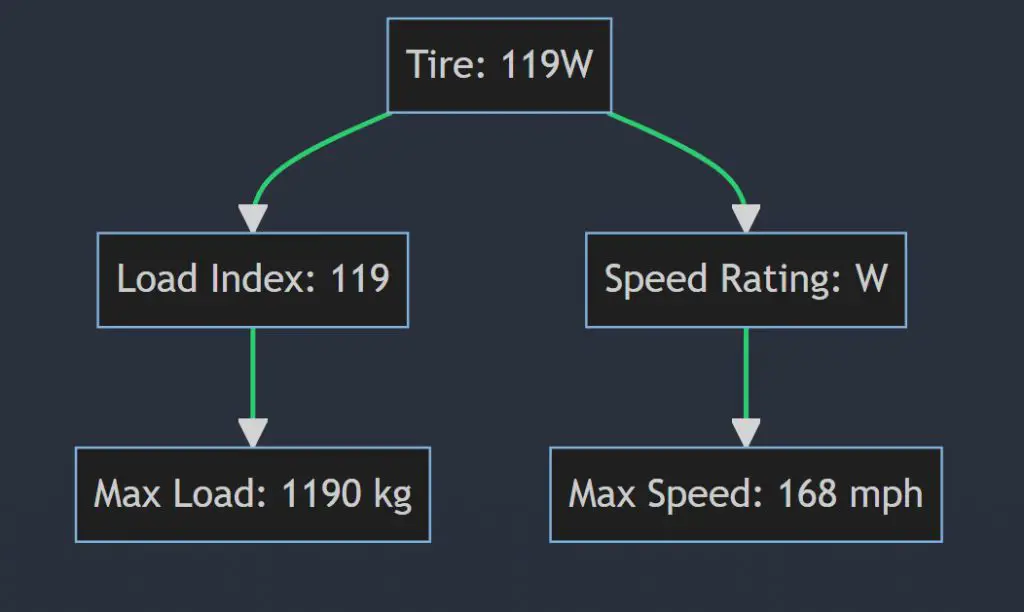
Last but certainly not least, let’s decipher the “120W”.
- Load Index: “120” denotes a load index of 1400 kilograms or 3086 pounds when the tire is properly inflated. That’s about the weight of 17,500 bananas. Talk about going bananas with comparisons!
- Speed Rating: “W” is the speed rating. This rating suggests that the tire can handle speeds up to 270 kilometers per hour or 168 miles per hour. That’s faster than a peregrine falcon’s dive, the fastest animal movement on earth.
A 120W tire is typically used for supercars, high-performance sports cars, and anyone who occasionally likes to test the limits on a racetrack. However, like the 120V, these tires can wear out faster due to the softer rubber compounds used for high grip at high speeds.
FAQs
1. 120R vs 120S – What’s the difference?
Well, there’s a bit of a mix-up here. “R” in tire codes usually stands for Radial construction, not a speed rating. The “120S”, on the other hand, refers to a tire with a load index of 120 and a speed rating of S (up to 180 km/h or 112 mph). If you see an “R” as a speed rating on your tire, it might be a misprint or refer to a specialized type of tire. Always consult your tire dealer in such cases.
2. 120R vs H120 – Which is better?
Again, “R” typically refers to Radial construction of a tire, not a speed rating. “H120”, however, seems to be flipped. It should be “120H”, which refers to a tire with a load index of 120 and a speed rating of H (up to 210 km/h or 130 mph). The choice between a supposed “120R” and a “120H” would depend on your vehicle’s requirements and your driving habits. Ensure you have the right information or consult a tire professional for advice.
3. 120R vs 120Q – What’s the difference?
As discussed earlier, “R” usually denotes Radial construction, while “120Q” refers to a tire with a load index of 120 and a speed rating of Q (up to 160 km/h or 99 mph). If there’s confusion or uncertainty about the tire code, it’s always best to seek expert advice.
Recap And Summary
Reading your tire’s sidewall is like reading a secret language. The tire codes – 120T, 120S, 120Q, 120H, 120V, 120W – each tell a unique story about the tire’s capabilities.
The number “120” refers to the tire’s load index, which is the maximum weight the tire can support when correctly inflated. This value translates to 1400 kg or 3086 lbs.
The following letters represent the tire’s speed rating, which tells you the top speed at which the tire can carry its load. T-rated tires can handle speeds up to 190 km/h (118 mph), S-rated up to 180 km/h (112 mph), Q-rated up to 160 km/h (99 mph), H-rated up to 210 km/h (130 mph), V-rated up to 240 km/h (149 mph), and W-rated up to 270 km/h (168 mph).
Choosing the right tire depends on your vehicle’s specifications and your driving style. So, the next time you’re tire shopping, don’t just look at the price tag. Decipher the code, unlock the secrets, and find the best tire that suits your needs. After all, as a wise person once said, “Life’s a journey, enjoy the ride” – especially when you have the right tires!
Alternative Tire Size Codes of Similar Specifications

AR Jeet has been a tire mechanic for over 2years. He has worked on all types of vehicles, from cars and trucks to RVs and ATVs and motorcycles. He has seen it all when it comes to tires, and he knows how to fix them.
AR Jeet is a tire expert, and he is passionate about his work. He loves to help people keep their vehicles running smoothly, and he is always happy to answer any questions that people have about their tires.
If you need help with your tires, or if you just want to learn more about them, then AR Jeet is the man to talk to. He will be happy to help you out, and he will make sure that you get the best possible solution.
He has a blog [Tirespick.com] where he writes about all things tire-related, and he is always happy to help people with their tire needs. Know more about AR Jeet.

